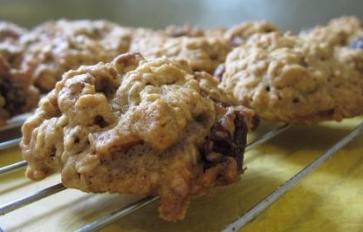
Were those tortilla chips you just finished baked or fried? Was your coworker’s birthday cake made with butter or margarine? And what was in the frosting?
Partially hydrogenated oil – or trans fat, as it’s now commonly known – was originally created in 1911 and took off during the Great Depression and World War II era. A German scientist proposed a method of adding hydrogen to liquid cottonseed oil to Procter & Gamble; P&G then marketed this product as Crisco (a product that my grandmother always had in her kitchen, and which was the star ingredient in her homemade biscuit recipe). Partially hydrogenated vegetable oils such as margarine began a trend that carried through the 1980s, popularized by a desire to limit the consumption of saturated fats such as butter and beef fat, especially. Since studies conducted at Harvard early in the 1990s, it is understood that trans fats contain little to be desired. Since 2006, food companies have been required by the FDA to list trans fat, saturated fat, and cholesterol content on labels, and the present push is to require removal of trans fats from all foods.
Trans fats occur both naturally and artificially. In nature, trans fats exist in animal products such as meat, whole milk, and other dairy products. Trans fats are artificially created by the process of adding hydrogen to liquid vegetable oils in order to form a solid fat. “Partially hydrogenated oil,” therefore, simply means that hydrogen has been added to make up part of the final product, which is oil in the form of solid fat. Trans fat may be listed as “0g trans fat” if the content is between 0g and .5g per serving. Paying attention to food labels can help, but sometimes one cannot rely solely on what the label says (or doesn’t say)…
Understanding what foods commonly contain trans fats, or partially hydrogenated oils, will help you to beat the skewed food labeling system. Here are some common foods that generally contain trans fat:
- Cakes, cookies, doughnuts, pastries and pies
- Frosting on the treats like those above
- Biscuits, like those from a can (trans fat that melts in the baking process is what makes ‘em flaky!)
- Margarine (Though most margarine brands have removed trans fat by now. In the past, margarine was the trans fat to replace butter.)
- [Cream-filled] candies (skip those fancy truffles and just get Valentine’s Day flowers!)
- Microwave popcorn (especially “Movie Theatre Butter” flavor)
- Crackers, chips, granola bars
- Salad dressing
- Frozen pizza or other similar frozen foods
- Fried fast foods
Fast food restaurants made the shift to use partially hydrogenated oil in the fryers in the 1980s because of the backlash against saturated fats (animal fats). Partially hydrogenated oils can be used and reused longer than other oils. If you’re interested in reading about which fast food restaurants are the worst offenders of trans fat in their menu, check out this list.
Reading labels and understanding how trans fat is formed and identified can be helpful in avoiding it. Keep an eye out for the term “partially hydrogenated oil” and reach for healthier alternatives to your favorite snacks and goodies.
Most importantly, trans fat is the fat you want to avoid most compared to other fats. Trans fat, like saturated fat, increases one’s LDL (low-density lipoprotein) cholesterol – the “bad” cholesterol that causes the buildup of fatty plaque in the arteries – and decreases one’s HDL (high-density lipoprotein) cholesterol, or the “good” cholesterol that is responsible for carrying excess cholesterol to the liver. An increase in LDL cholesterol also increases one’s chances of heart disease, heart attack, stroke, and type 2 diabetes.
Like trans fats, saturated fats exist as solids at room temperature; saturated fats, however, are naturally occurring in animal products like beef, pork, chicken, and milk products. Unsaturated fats exist as liquids at room temperature, and typically come from plant products like olives, nuts, and seeds. Unsaturated fats also exist in fish, too, and are generally referred to as oils. (Note: although coconut oil, palm oils, and whole milk exist as a liquid at room temperature, they are high in saturated fat.) Unsaturated fats contain mostly monounsaturated and polyunsaturated fats. Limiting saturated fat and trans fat is advisable; unsaturated fats -- oils -- provide essential fatty acids and vitamin E and should be the favored type of fat in one’s diet.
The Mayo Clinic recommends that fat should be between 20-35% of one’s daily caloric intake, and only 10% of that should be saturated fat (of which trans fat is a type). Replacing trans fats with unsaturated omega-3 fatty acids found in fish, nuts, and avocados is highly recommended, especially if family members have a history of coronary diseases such as heart attack and stroke.
Fortunately, the FDA estimates that nearly 80% of all trans fats are already eliminated from U.S. foods. A national ban on trans fats will go into effect in 2018, and Yale University has already conducted a study showing that the ban will decrease the instance of both fatal and non-fatal heart attacks and strokes. Given the growing understanding of the detrimental effects of trans fat in the body and more health-conscious alternatives to trans fats, the trans fat ban could certainly have wide-reaching effects throughout the country.
…Will microwave popcorn and other sweet treats become a thing of the past?








